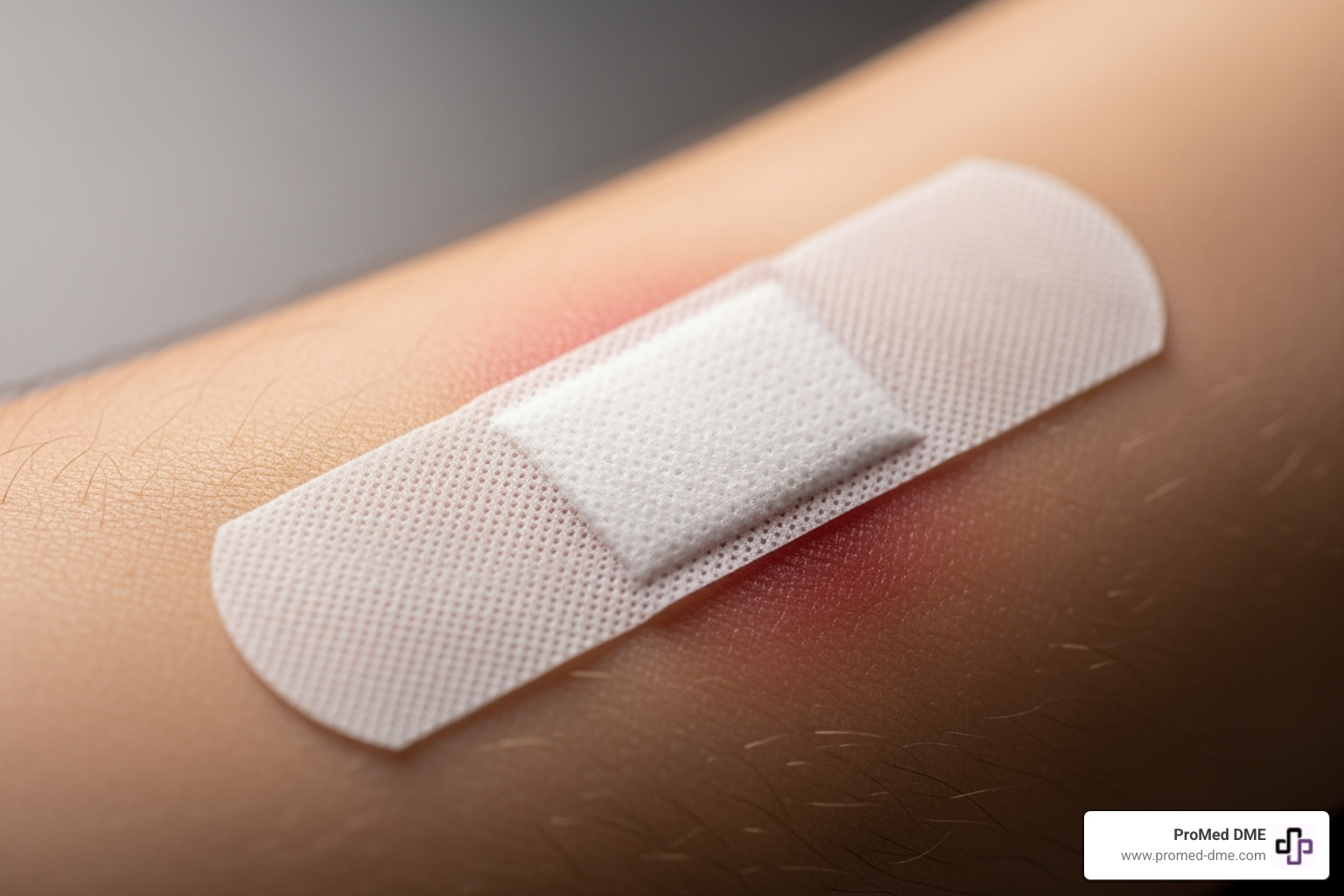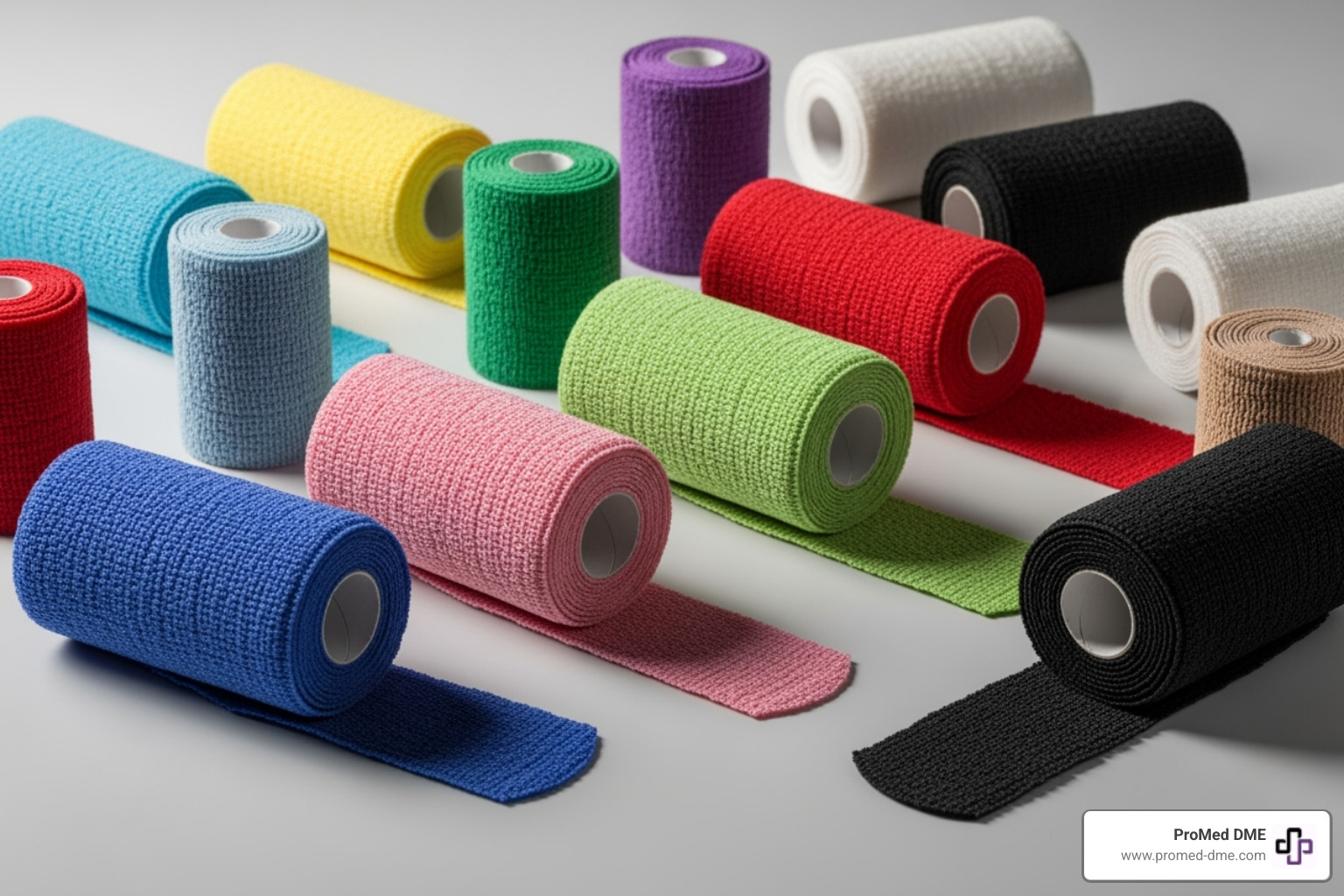What Are Silicone Foam Dressings and How Do They Work?
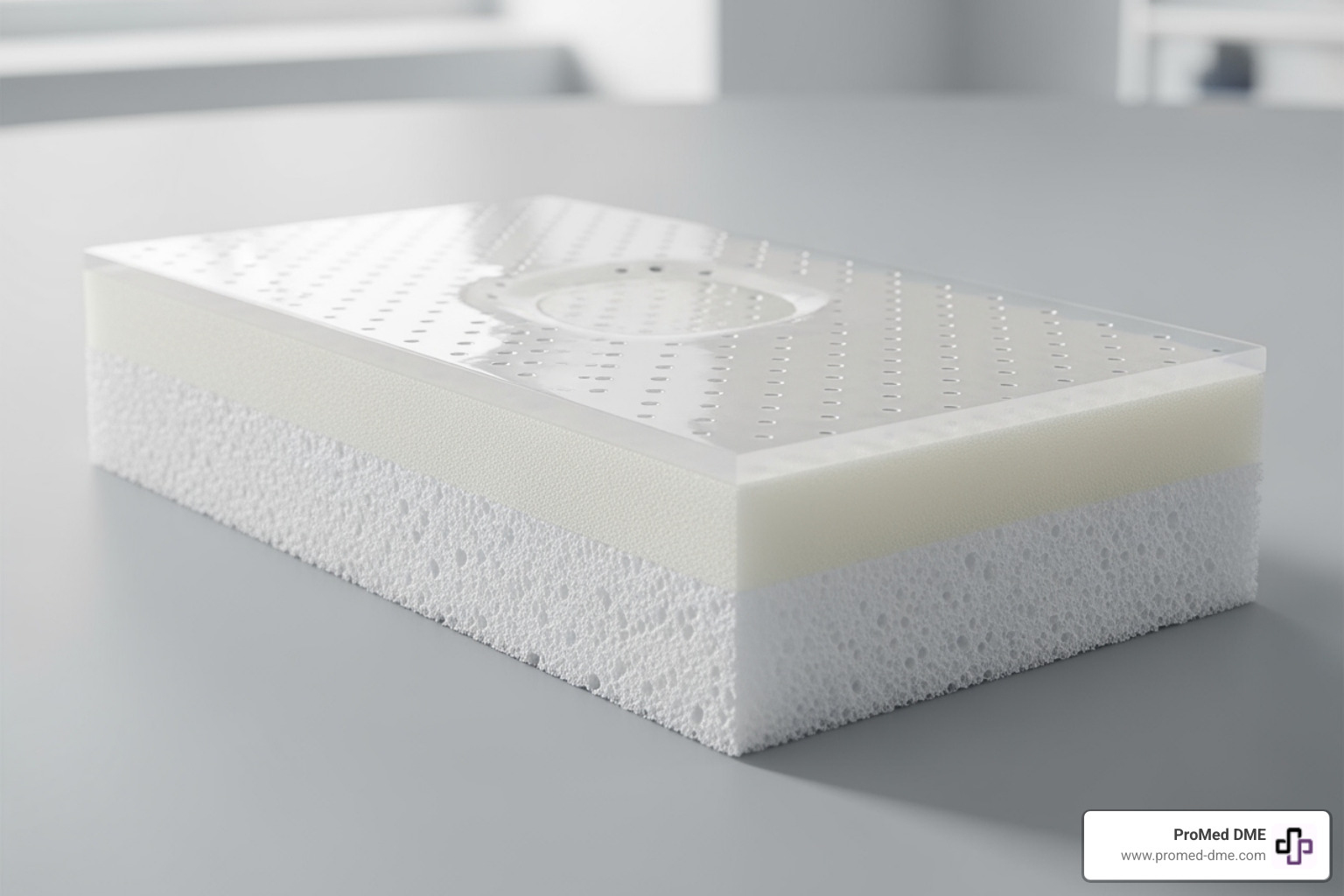
Understanding the Evolution of Advanced Wound Care
Silicone foam dressing is an advanced wound care product that combines a soft silicone contact layer with an absorbent foam core to manage wound exudate while promoting healing and minimizing pain during dressing changes.
Key Facts About Silicone Foam Dressings:
- What They Are: Multi-layer dressings with a gentle silicone adhesive layer, highly absorbent foam pad, and waterproof backing
- How They Work: Absorb up to 15 times their weight in wound fluid while maintaining a moist healing environment
- Primary Benefits: Pain-free removal, reduced skin trauma, superior exudate management, and can stay in place for up to 7 days
- Best For: Moderate to heavily exuding wounds including pressure ulcers, diabetic ulcers, surgical wounds, and skin tears
- Who Uses Them: Healthcare professionals and patients managing chronic or acute wounds at home or in clinical settings
If you're managing a chronic wound or recovering from surgery, you've likely heard about these dressings from your healthcare provider. Unlike traditional gauze that can stick to wounds and cause pain during removal, silicone foam dressings represent a significant leap forward in wound care technology.
The difference is clear: while regular bandages often require daily changes and can damage fragile skin, silicone foam dressings stay comfortably in place for several days. They work by gently adhering to the healthy skin around your wound without sticking to the wound bed itself—meaning less pain, fewer dressing changes, and better healing outcomes.
For retirement-aged individuals dealing with diabetes, pressure ulcers, or post-surgical recovery, these dressings offer a practical solution that reduces both discomfort and the frequency of care needed. They're designed to absorb significant amounts of wound drainage while protecting your skin and promoting the moist environment wounds need to heal properly.
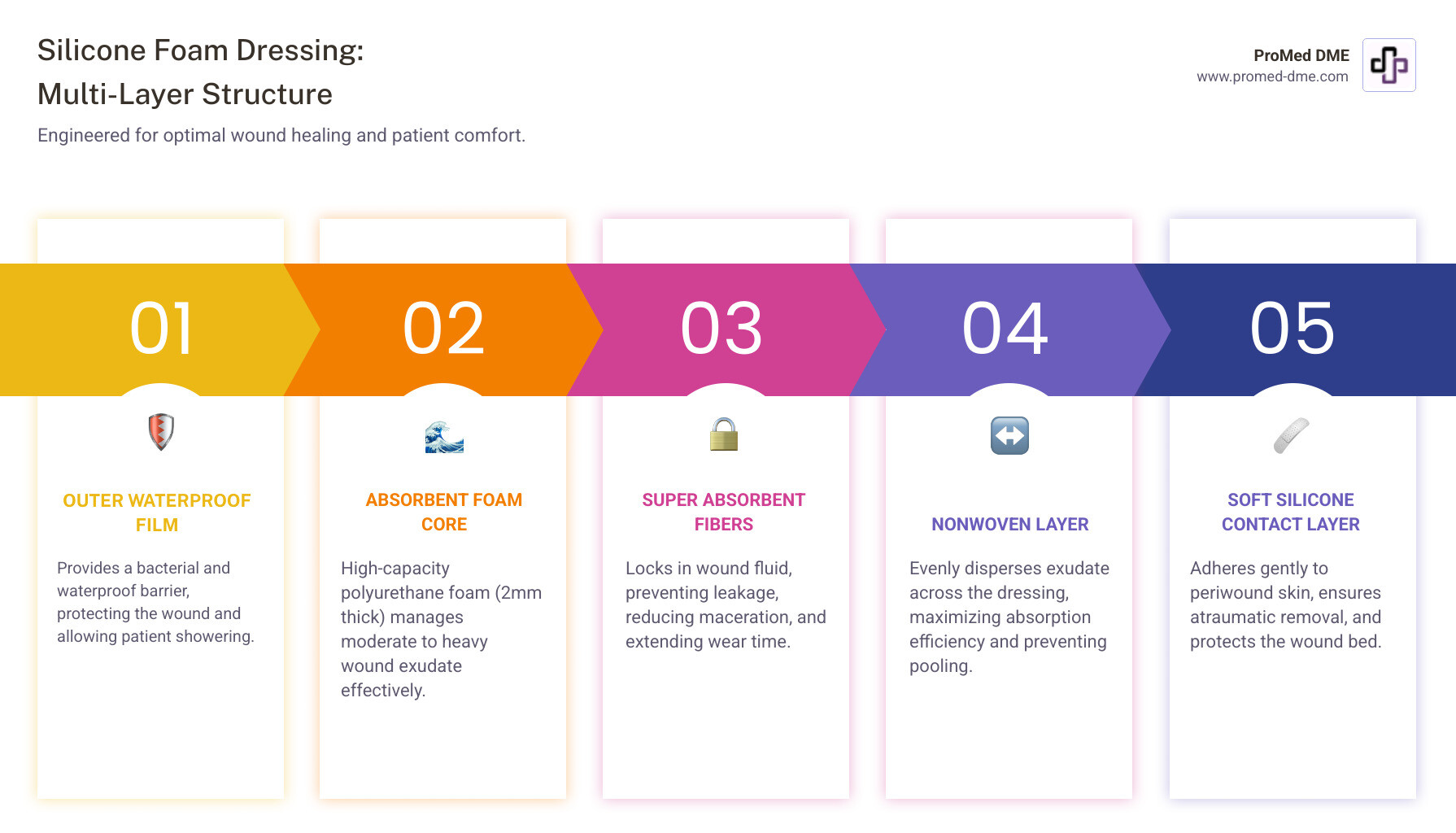
The Science Behind Silicone Foam: Key Components and Mechanism
Think of a silicone foam dressing as a sophisticated piece of engineering designed specifically for your wound. At ProMed DME, we've seen how understanding the science behind these dressings helps patients appreciate why they work so effectively. These aren't your grandmother's bandages—they're carefully constructed medical devices that work with your body's natural healing processes.
The magic happens through three primary components working together: a soft polyurethane foam that acts like a highly efficient sponge, a gentle silicone adhesive that sticks to healthy skin without grabbing onto your wound, and a protective outer film that shields everything while still letting your skin breathe. The foam layer is hydrophilic, meaning it loves water and pulls wound fluid away from the injury. Meanwhile, the silicone adhesive is hydrophobic—it repels moisture and won't stick to the wet wound bed itself. This intelligent combination means your dressing stays securely in place while your wound gets the protection it needs.

The Multi-Layer Construction
Silicone foam dressings are built like a high-tech sandwich, with each layer serving a specific purpose. Starting from the inside and working outward, you'll find the wound contact layer made of soft silicone. This layer adheres gently to the healthy skin surrounding your wound but won't stick to the wound itself—which is exactly what you want for a pain-free dressing change. Many designs feature tiny perforations in this silicone layer that help wound fluid move quickly into the next layer.
Above that sits the absorbent foam core, typically made from polyurethane. This is the workhorse of the dressing, designed to soak up and hold significant amounts of wound drainage. Some advanced dressings feature a specialized foam core that can hold up to 15 times their own weight in wound exudate.
Next comes the super absorbent fiber layer, which acts like a one-way valve. Once wound fluid gets pulled into this layer, it stays locked away, preventing it from seeping back toward your skin. This is crucial for preventing maceration, which is when the skin around your wound becomes soft and breaks down from too much moisture. A nonwoven layer often sits within the absorbent core, spreading the wound fluid evenly throughout the dressing so no single spot gets oversaturated.
Finally, the outermost layer is a waterproof yet breathable backing, usually made from polyurethane film. This protective barrier keeps out bacteria and water (yes, you can shower with these dressings on), while still allowing moisture vapor and gases to pass through. This breathability makes all the difference between a healthy healing environment and a damp, problematic one.
How They Create an Optimal Healing Environment
The genius of silicone foam dressings lies in how they support your body's natural healing process. For years, it was thought wounds needed to dry out and form a scab to heal. We now know that wounds heal faster and better when they're kept in a moist environment—not soaking wet, just appropriately hydrated.
These dressings excel at moist wound healing by maintaining the right level of moisture at the wound bed. The foam absorbs excess fluid while keeping the wound from drying out, creating the perfect conditions for new cells to grow. This balanced moisture level supports the cellular activity that's essential for tissue repair.
Exudate management is another critical function. The multi-layer design effectively absorbs and locks away this exudate, keeping it from damaging the healthy skin around your wound. This excellent fluid management sets silicone foam dressings apart from traditional bandages.
The breathable outer film allows for gas exchange, letting oxygen reach the wound while carbon dioxide escapes. The foam layer also provides thermal insulation, maintaining a stable temperature at the wound site. This consistent warmth supports the enzymatic activity and cellular functions involved in tissue repair.
By efficiently absorbing and locking away excess drainage, these dressings prevent maceration—the softening and breakdown of skin that happens when it stays too wet. The periwound skin stays healthy and intact, which is crucial for proper healing. And because the silicone contact layer is so gentle, it protects newly formed tissue during dressing changes, supporting continuous cellular growth without disruption.
Unpacking the Benefits: Why Choose a Silicone Foam Dressing?
When it comes to wound care, the benefits of silicone foam dressings are truly transformative. We often hear from our customers at ProMed DME about the positive impact these dressings have on their daily lives. From improved patient comfort to accelerated healing and reduced scarring, they offer a comprehensive solution that traditional dressings simply can't match.
Promoting Pain-Free Healing
One of the most significant advantages of silicone foam dressings is their ability to promote pain-free healing. Wound-related pain is a major concern for patients, especially during dressing changes. This is where silicone truly shines:
- Gentle Adhesion: The soft silicone wound contact layer adheres gently to the surrounding skin but not to the wound bed. This unique property means that when it's time to change the dressing, it comes off smoothly, without tugging at delicate healing tissue.
- Non-Stick Wound Contact: Because the silicone doesn't stick to the wound itself, new granulation tissue and epithelial cells are left undisturbed. This minimizes trauma to the wound, which is crucial for continuous, healthy healing.
- Minimized Skin Stripping: Fragile skin, common in retirement-aged individuals, is highly susceptible to damage from aggressive adhesives. The gentle nature of silicone significantly reduces the risk of skin stripping and irritation around the wound.
- Nerve Ending Protection: By creating a soft barrier and minimizing trauma, these dressings help protect exposed nerve endings in the wound bed, contributing to overall pain reduction.
- Cushioning Effect: The foam core provides a soft, protective cushion over the wound, shielding it from external bumps and pressures, further enhancing comfort.
This gentle approach not only makes dressing changes less dreaded but also fosters a more positive healing experience.
Superior Exudate Management
Effective management of wound exudate (fluid) is critical to preventing complications like maceration and promoting a healthy healing environment. Silicone foam dressings are expertly designed for this purpose:
- High Absorbency: The foam core, often combined with a Super Absorbent Fiber (SAF) layer, is incredibly efficient at absorbing large volumes of exudate. Some dressings can absorb up to 15 times their weight in wound fluid.
- Fluid Locking: Once absorbed, the exudate is locked within the dressing's layers, preventing it from leaking out or re-wetting the periwound skin.
- Periwound Skin Protection: By keeping excess moisture away from the surrounding healthy skin, these dressings significantly reduce the risk of maceration, a common issue that can enlarge wounds and delay healing.
- Reduced Leakage: The combination of high absorbency and a waterproof outer film minimizes the chances of leakage, providing peace of mind.
- Extended Wear Time: Thanks to their superior absorbency, silicone foam dressings can be safely worn for several days, depending on wound condition. This means fewer dressing changes, which translates to less disruption to the wound, less pain, and more convenience. Dressings can often remain in place for up to 7 days.
Comparing to Traditional Dressings
When we compare them to silicone foam dressings, the advantages of modern wound care become clear:
- Gauze Comparison: Gauze can stick to the wound bed, causing pain and damaging new tissue upon removal. It also has limited absorbency and requires frequent changes, increasing infection risk and disrupting healing.
- Traditional Bandages: Similar to gauze, many traditional adhesive bandages have aggressive adhesives that can strip fragile skin. They also lack the advanced fluid management capabilities of foam dressings, often leading to maceration or leakage.
- Less Frequent Changes: While traditional dressings might need changing daily, silicone foam dressings can often stay in place for several days. This reduces exposure of the wound to the environment and minimizes pain during changes.
- Improved Patient Outcomes: All these factors—pain reduction, superior fluid management, skin protection, and less trauma—contribute to faster, more efficient healing. Reduced scarring is also a notable benefit when wounds heal optimally without repeated disruption.
Choosing a silicone foam dressing is about embracing a modern approach to wound care that prioritizes comfort, efficacy, and better healing.
Your Practical Guide to the Silicone Foam Dressing
Navigating wound care can be overwhelming, but we're here at ProMed DME to make it simpler. Understanding how to use silicone foam dressings properly makes all the difference in your healing journey. These versatile dressings come in various shapes and sizes designed to fit just about any wound.
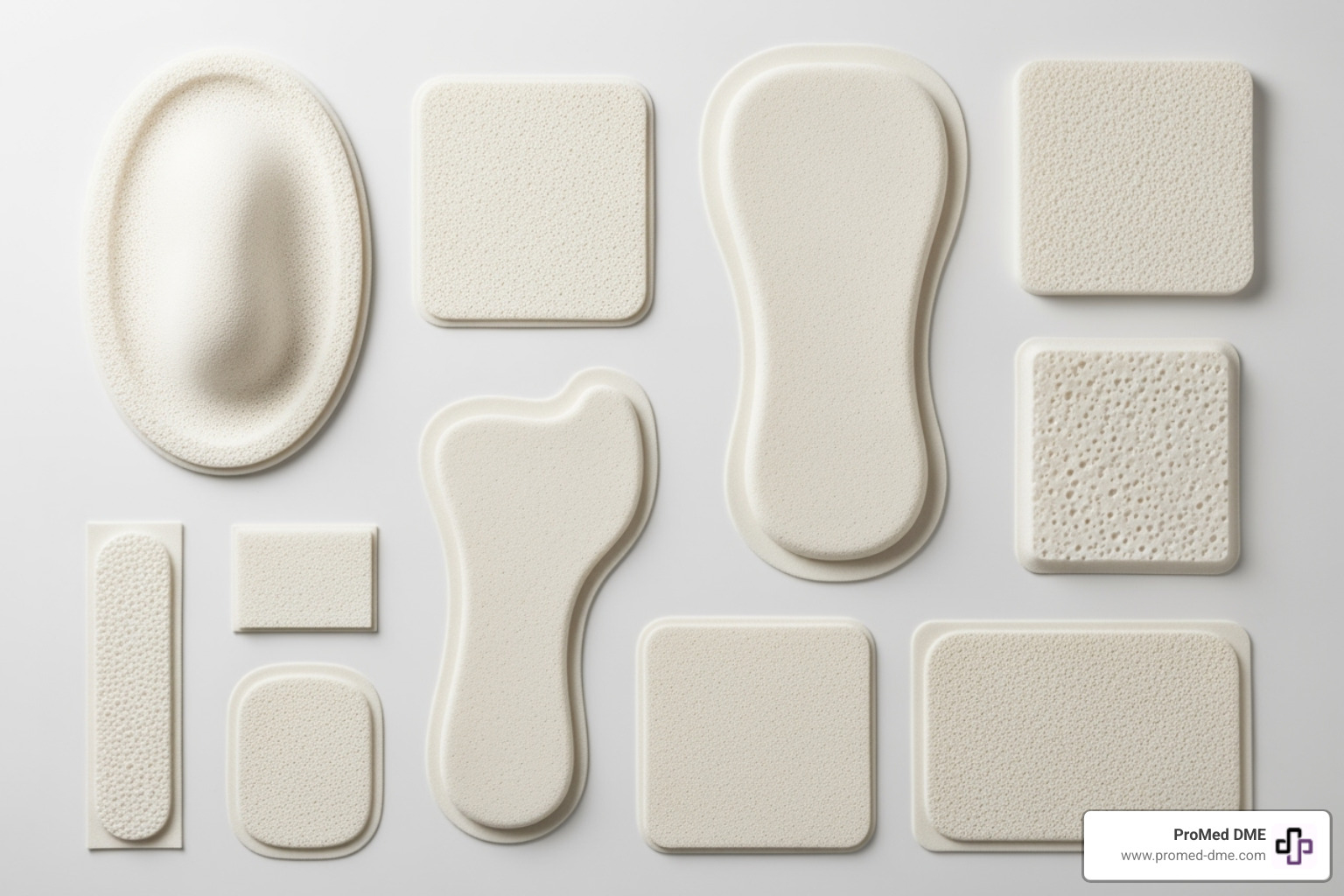
What Types of Wounds Are Best for a Silicone Foam Dressing?
Silicone foam dressings work beautifully for a wide range of wounds, especially those producing moderate to heavy amounts of fluid. Their ability to absorb significant drainage while protecting delicate tissue makes them a favorite among healthcare professionals.
If you're dealing with pressure ulcers (bedsores), these dressings are particularly effective. The gentle adhesion and superior absorption help promote healing. Scientific research has demonstrated their remarkable ability to prevent pressure ulcers in high-risk patients. Learn more about the scientific research on pressure ulcer prevention here. We even carry specialized shapes designed for vulnerable areas like the sacrum and heel.
Diabetic foot ulcers respond well to silicone foam because the moist healing environment and gentle removal protect the fragile skin common in diabetes patients. The same goes for venous leg ulcers, which often produce considerable drainage that these dressings handle with ease.
For post-surgical wounds with drainage, you'll appreciate how these dressings absorb fluid while protecting the incision site. The gentle removal is especially important during the delicate post-operative period.
Skin tears, common in older adults with thin, fragile skin, are an ideal application for silicone foam dressings, which protect the area without causing additional trauma during changes. They're also excellent for first and second-degree burns, providing cushioning and a moist environment.
Beyond these common applications, silicone foam works well for traumatic wounds like abrasions and lacerations, as well as graft and donor sites.
How to Correctly Apply and Remove Your Dressing
Proper application is straightforward once you know the steps. Start by washing your hands thoroughly with soap and water. Next, clean the wound and surrounding skin according to your healthcare provider's instructions. It is crucial that the skin around the wound is completely dry before you apply the dressing to ensure proper adhesion.
Choose a dressing size that extends at least an inch beyond the wound edges. When you're ready to apply, carefully peel away the protective backing from the adhesive side, trying not to touch the sticky surface.
Center the dressing over the wound and gently smooth it down. Do not stretch the dressing as you apply it, as this creates tension that can cause it to pull away.
When it's time to remove the dressing, gently lift one corner and slowly pull the dressing parallel to your skin surface, stretching it slightly. This "stretch release" technique breaks the adhesive bond gently, causing minimal discomfort. Continue peeling it away, always moving parallel to the skin, until it's completely removed. After removal, dispose of the used dressing, cleanse the wound site as needed, and assess the wound before applying a fresh dressing.
Choosing the Right Silicone Foam Dressing: Sizes, Styles, and Precautions
The variety of silicone foam dressings available means you can find the perfect fit for your specific needs.
Many dressings come with an adhesive border that makes them self-adherent. Non-bordered versions offer more flexibility if you prefer using your own securing method.
For wounds in challenging locations, anatomical shapes are game-changers. Sacral dressings are specifically designed for the tailbone area, while heel dressings wrap around the heel's unique shape, providing maximum contact and cushioning.
Standard shapes—square, rectangular, and oval—come in numerous sizes to fit wounds of almost any dimension, from small 2"x2" dressings up to large 8"x8" sizes.
While silicone foam dressings are safe and effective for most situations, there are a few important considerations. They are not intended for third-degree burns or completely dry wounds. If you have a known allergy to silicone (though rare), you'll need to avoid these dressings.
Unless the manufacturer specifically states you can cut the dressing, keep it intact. Cutting can compromise the waterproof outer layer. Each dressing is designed for single use only—never reuse one. If your wound shows signs of infection, worsens, or you have any concerns, reach out to your healthcare provider.
Frequently Asked Questions about Silicone Foam Dressings
Over the years, we've noticed some questions come up time and again about silicone foam dressings. Let's explore the most common ones.
How long can a silicone foam dressing stay on a wound?
Silicone foam dressings are designed for extended wear, which means fewer dressing changes and less disruption to your healing. In most cases, these dressings can stay in place for up to 7 days.
Of course, every wound is unique, and the actual wear time depends on the wound condition and the exudate level. While these dressings are highly absorbent, they do have limits.
You'll know it's time for a change when you notice certain signs: the fluid is approaching the edges of the dressing, the foam core looks saturated, or if the dressing starts lifting at the corners. Other red flags include visible soiling, an unusual odor, or any signs that might suggest infection—like increased pain, redness, or swelling around the wound site.
Your healthcare professional is your best resource here. They can assess your specific wound and give you personalized guidance on how often to change your dressing. Our dedicated nurse on staff at ProMed DME is also always available if you have questions between appointments.
Can you shower with a silicone foam dressing?
Yes, this is one of the features our customers love. Most silicone foam dressings are showerproof due to the waterproof backing—the outer polyurethane film layer. It creates a protective barrier that keeps water out while still letting your skin breathe.
To make sure everything stays protected during your shower, check that the dressing has secure adhesion all around the edges before you step under the water. While the dressing is designed to handle water, it's still a good idea to avoid pointing a strong, direct stream of water right at it for extended periods.
After your shower, gently pat the area with a clean towel—no rubbing. Rubbing could loosen the adhesive or irritate your skin. Maintaining good hygiene is important for both your physical and mental well-being. If you're ever unsure whether your specific dressing is truly showerproof, just check the product packaging or give us a call at ProMed DME.
Can a silicone foam dressing be cut to size?
This depends on the specific product you're using. The golden rule is to always check manufacturer instructions first. Some silicone foam dressings are designed with cutting in mind, while others specifically shouldn't be altered.
If your dressing's instructions say cutting is okay, make sure you use sterile scissors to keep everything clean. If you're working with a bordered dressing, cutting into that adhesive border can compromise the sterile field and might affect how well the dressing stays in place. The goal is maintaining a sterile border and ensuring a proper seal.
Non-bordered dressings tend to be more forgiving when it comes to customization since they're designed to be secured with secondary dressings or tape. These give you more flexibility to create custom shapes if needed.
That said, before you reach for the scissors, consider whether a better-fitting option is already available, like the sacral and heel dressings shaped for tricky areas. When you're unsure about cutting your dressing, don't hesitate to reach out to your healthcare provider or contact us at ProMed DME.
Conclusion: The Modern Solution for Effective Wound Care
We've covered a lot of ground together, and if there's one thing we hope you take away, it's this: silicone foam dressings truly represent a modern breakthrough in how we approach wound healing. They're not just another bandage—they're a thoughtfully engineered solution that addresses the real challenges people face when managing wounds.
Think about what we've learned. The multi-layer construction works like a well-coordinated team, with each layer playing its part. The gentle silicone adhesion means no more dreading dressing changes or worrying about damaging fragile skin. The superior fluid management keeps wounds in that optimal healing environment while protecting the surrounding skin from maceration. And the ability to wear a single dressing for several days? That's not just convenient—it means less disruption to the healing process, less pain, and more time for living your life.
For our customers dealing with pressure ulcers, diabetic foot ulcers, post-surgical wounds, or any of the other conditions we've discussed, these dressings can genuinely transform the healing experience. We've heard countless stories from people who tell us they wish they'd finded these dressings sooner. The difference in comfort alone is remarkable, but when you add in faster healing times and better outcomes, it's clear why healthcare professionals increasingly recommend them.
At ProMed DME, we're more than just a medical supply company. We're your partners in healing. Our team understands that navigating wound care can feel overwhelming, especially when you're already dealing with health challenges. That's why we've built our entire approach around making things easier for you. Our dedicated nurse on staff is always available to answer questions, help you choose the right products, and provide guidance when you need it most.
We also believe that quality wound care shouldn't break the bank. That's why we offer free shipping on all orders and work with most insurance plans to minimize your out-of-pocket costs. We want you to have access to the best possible care without financial stress adding to your worries.
Whether you're managing a chronic wound yourself or caring for a loved one, we're here to support you every step of the way. These advanced dressings represent hope—hope for reduced pain, improved healing, and a better quality of life during your recovery journey.
Ready to experience the difference that modern wound care technology can make? Find the right wound care solutions for your needs at ProMed DME and take the next step toward more comfortable, effective healing. Your wound care journey doesn't have to be difficult, and we're here to prove it.
Related Resources & Articles
Stay informed with our informative blog posts.
Discover the ProMed Advantage
& Try Our Products
We offer free shipping and legendary customer service to ensure you receive the
best DME products for your needs.

